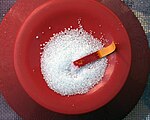Sodium bisulfate
| |||

| |||
| Names | |||
|---|---|---|---|
| IUPAC name
Sodium hydrogen sulfate
| |||
| Other names
Sodium acid sulfate
Bisulfate of soda | |||
| Identifiers | |||
| |||
3D model (JSmol)
|
|||
| ChemSpider | |||
| ECHA InfoCard | 100.028.787 | ||
| EC Number |
| ||
| E number | E514(ii) (acidity regulators, ...) | ||
PubChem CID
|
|||
| RTECS number |
| ||
CompTox Dashboard (EPA)
|
|||
| |||
| |||
| Properties | |||
| NaHSO4 | |||
| Molar mass | 120.06 g/mol (anhydrous) 138.07 g/mol (monohydrate) | ||
| Appearance | white solid | ||
| Density | 2.742 g/cm3 (anhydrous) 1.8 g/cm3 (monohydrate) | ||
| Melting point | 58.5 °C (137.3 °F; 331.6 K) (monohydrate) 315 °C (anhydrous) | ||
| Boiling point | decomposes to Na2S2O7 (+ H2O) at 315 °C (599 °F; 588 K) | ||
| 28.5 g/100 mL (25 °C) 100 g/100 mL (100 °C) | |||
| Solubility | Insoluble in ammonia | ||
| Acidity (pKa) | 1.99 | ||
| Structure | |||
| triclinic (anhydrous) monoclinic (monohydrate) | |||
| Hazards | |||
| NFPA 704 (fire diamond) | |||
| Flash point | Non-flammable | ||
| Safety data sheet (SDS) | External MSDS | ||
| Related compounds | |||
Other anions
|
Sodium sulfate | ||
Other cations
|
Potassium bisulfate | ||
Except where otherwise noted, data are given for materials in their standard state (at 25 °C [77 °F], 100 kPa).
| |||
Sodium bisulfate, also known as sodium hydrogen sulfate,[1] is the sodium salt of the bisulfate anion, with the molecular formula NaHSO4. Sodium bisulfate is an acid salt formed by partial neutralization of sulfuric acid by an equivalent of sodium base, typically either in the form of sodium hydroxide or sodium chloride. It is a dry granular product that can be safely shipped and stored. The anhydrous form is hygroscopic. Solutions of sodium bisulfate are acidic, with a 1M solution having a pH of around 1.
Production
One production method involves mixing stoichiometric quantities of sodium hydroxide and sulfuric acid which react to form sodium bisulfate and water.
- NaOH + H2SO4 → NaHSO4 + H2O
A second production method involves reacting sodium chloride (salt) and sulfuric acid at elevated temperatures to produce sodium bisulfate and hydrogen chloride gas.
- NaCl + H2SO4 → NaHSO4 + HCl
The liquid sodium bisulfate is sprayed and cooled so that it forms a solid bead. The hydrogen chloride gas is dissolved in water to produce hydrochloric acid as a useful coproduct of the reaction. Sodium bisulfate is also produced as a byproduct of the production of many other mineral acids via the reaction of their sodium salts with an excess of sulfuric acid:
In most cases, the acids produced have a lower boiling point than the reactants and are separated from the reaction mixture by distillation.
There are only two producers in the USA, one being Jones-Hamilton Co., who uses the sulfuric acid/sodium chloride process, which produces the anhydrous form. The other supplier, Jost Chemical, uses the sodium hydroxide/sulfuric acid method, which produces the monohydrate.
Uses
Sodium bisulfate is used primarily to lower pH. For technical-grade applications, it is used in metal finishing, cleaning products,[2] and to lower the pH of water for effective chlorination in swimming pools and hot tubs. Sodium bisulfate is also AAFCO approved as a general-use feed additive, including companion animal food. It is used as a urine acidifier to reduce urinary stones in cats.
It is highly toxic to at least some echinoderms, but fairly harmless to most other life forms; sodium bisulfate is used in controlling outbreaks of crown-of-thorns starfish.
In jewelry making, sodium bisulfate is the primary ingredient used in many pickling solutions to remove the oxidation layer from surfaces, which occurs after heating.[3] Sodium bisulfate was the primary active ingredient in crystal toilet bowl cleaners Vanish and Sani-Flush, both now discontinued.[4]
In the textiles industry, it is sometimes applied to velvet cloth made with a silk backing and a pile of cellulose-based fiber (rayon, cotton, hemp, etc.) to create "burnout velvet": the sodium bisulfate, when applied to such a fabric and heated, causes the cellulose-based fibers to become brittle and flake away, leaving burned-out areas in the finished material, usually in attractive patterns.[5]
In food
Sodium bisulfate is used as a food additive to leaven cake mixes (make them rise)[dubious – discuss] as well as being used in meat and poultry processing and most recently in browning prevention of fresh-cut produce.[citation needed] Sodium bisulfate is considered generally recognized as safe (GRAS) by the FDA. The food-grade product also meets the requirements set out in the Food Chemicals Codex. It is denoted by E number E514ii in the EU and is also approved for use in Australia, New Zealand, Canada, and Mexico.[6] where it is listed as additive 514. Food grade sodium bisulfate is used in a variety of food products, including beverages, dressings, sauces, and fillings. It has many synonyms including[7] bisulfate of soda, sodium acid sulfate, mono sodium hydrogen sulfate, sodium hydrogen sulfate, sodium hydrosulfate, and sulfuric acid sodium salt (1:1).
References
- ^ The prefix "bi" in "bisulfate" comes from an outdated naming system and is based on the observation that there is two times as much sulfate (SO4) in sodium bisulfate (NaHSO4) and other bisulfates as in sodium sulfate (Na2SO4) and other sulfates.
- ^ John Toedt, Darrell Koza, Kathleen Van Cleef-Toedt Chemical Composition of Everyday Products p.147
- ^ Fisch, Arline M. (2003), Textile Techniques in Metal: For Jewelers, Textile Artists & Sculptors, Lark Books, p. 32, ISBN 978-1-57990-514-9.
- ^ SANI-FLUSH® Powder (Discontinued), Reckitt Benckiser.
- ^ Margo Singer (11 July 2007). Textile Surface Decoration: Silk and Velvet. University of Pennsylvania. p. 35. ISBN 0-8122-2000-5.
- ^ Australia New Zealand Food Standards Code
- ^ Noshly



